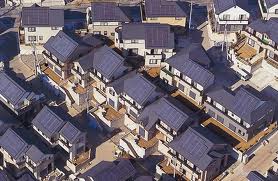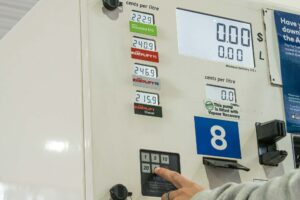There was a huge response to our article on Wednesday, summarising the UBS report on how a boom in un-subsidised solar installations would cause a revolution in energy markets. Most people wanted more details of how UBS arrived at their calculations, so we’ve decided to share more of their report on what makes solar PV – and battery storage – such a compelling proposition to households and businesses, even without subsidies.
There are two principal pieces to the equation – the falling cost of solar and battery manufacturing on one side, and the rising cost of grid-based electricity on the other. UBS estimates the total cost of installed solar PV (including inverters and balance of systems costs) has fallen by well over half in the last few years, and will continue to do so, while grid prices (ironically including the cost of renewable subsidies) have risen and will continue to do so.
“In combination, we see this as a game-changer for the competitiveness of solar systems,” the UBS energy team writes. “Private households and commercial users will be able to save on their electricity bills if they install a solar system – without any benefits from subsidies.” As we noted yesterday, just on economics, it said every household in Germany, Italy and Spain should have a solar system by the end of the decade.
UBS says unsubsidised solar systems are now at break-even but, on its estimates, the payback time of unsubsidised solar systems will shrink to some five years for commercial installations and some 10 years for residential rooftops by 2020. It says the economics work in Germany, Italy and Spain, even if financing might be a problem for the latter economy.
As an example, UBS gave the cost of a family-home rooftop solar system (4kWp) in Germany at today’s prices (€7,400 fully installed) – which amortised over 20 years equated to €450 a year. Without subsidies, a solar system’s profitability depends almost entirely on the amount of solar power directly consumed by its owner (rather than sold back into the grid with a feed in tariff).
UBS estimates a 4,500kWh household with a 4kWp PV system should be able to reduce its electricity purchases from a utility by 30 per cent without significantly changing its consumption habits. In southern Germany, such a household would save around €380 on its electricity bill, which would otherwise amount to some €1,260. Another €80 of income results from the sale of excess electricity if a price of 25 €/MWh is assumed. In the example above, it would already be worth installing a PV system, as the combined cost would be slightly smaller. It says solar PV systems will become even more attractive as retail tariffs continue to rise, and solar costs continue to fall.
As well, the increase in unsubsidised solar PV capacity will ultimately lead to higher electricity prices, because the demand reduction will force utilities to spread the grid investments and cost of the renewable subsidies over a smaller base. But as grid prices rise, households will respond by increasing their self-consumption rate.
They could do this by co-ordinating the timing of energy-intensive processes, aiming at increasing the self- consumption rate of a PV system, in the same way utilities offer time-of use meters. Solar developers are already offering such technology. And/or they could add a battery storage system, which UBS describes as the other big game changer in the energy game.
UBS says storage technologies allow the owner of a solar PV system to further cut electricity purchases from utilities: either because they can store solar PV power not immediately consumed, or they could charge the battery on low rates overnight for use in the morning or at other time.
UBS notes that According to different field tests suggest a battery with a capacity of 3kWh allows a 4,500kWh household with a 4kWp PV system to lower its electricity consumed from the grid by 50-60%. (Note that this graph below is for Germany).
On battery storage technology, UBS notes that traditional battery technologies from the vehicle sector, such as lead-acid batteries, have mainly been used as back-up solution for blackouts. While low cost (50-800 €/kWh), their lifetime is limited to 2-6 years, and give a maximum of up to 2,000 cycles. Other technologies, such as lithium-ion batteries, are more promising, given deep-cycle resistance, a long lifetime, and higher cost-reduction potential in the near future.
UBS says although the products already available come at an end-customer cost of €1,500-2,500 per kWh of usable storage capacity – and a battery management system is also needed, which adds another 500-1,000 €/kWh to the costs for small-scale PV systems – these products are the first of their kind and are not yet produced at large scale, and they contain high margins for sales agents (up to 30%).
“We expect the end-customer cost of lithium-ion technology applied in the PV sector to decline significantly over the next few years. We do not attribute this to any technological leaps, but rather to the start of industrial manufacturing, which should lead to lower unit costs; higher production volumes should improve components purchase conditions, and a more widespread application should decrease margins for sales agents,” UBS says. And because the characteristics required by batteries used to store solar power are similar to those for batteries used in e-vehicles, progress in the production of batteries for e-vehicles should directly benefit solutions in the field of solar power storage.
“We also highlight that the current cost of an e-vehicle battery pack based on the lithium-ion technology and manufactured at low volumes ranges from 800 to 900 €/kWh, while in the area of consumer electronics, the battery cost ranges from 200 to 300 €/kWh. In our analysis, we assume that a complete battery solution for storing PV power currently comes at a total cost of 2,500-3,000 €/kWh and will decline by 10% per year.”
The first graph below compares the current retail price of electricity in Germany with the cost of PV and battery at different battery technology costs. It assumes that the price of solar PV is constant (which it is not).
This second graph below highlights the benefits that could be delivered to a household in Germany that has both PV and battery storage, with the retail price moving relentlessly higher, and the cost of PV and batteries delivering a significant discount.
Note that the cost of these technologies will be lower in southern Germany, primarily because of the better solar resources. UBS notes that in Spain, a 3.5kWp solar PV system could deliver the same output as a 5.5kWp system in Germany, which would make that attractive even though retail prices in Spain are not as high as in Germany.
UBS says solar PV without subsidies will also be very attractive to commercial groups – particularly stores, supermarkets and offices, but also to most manufacturing enterprises that operate during daytime, because they can consume virtually all of the electricity they produce, and because some could use cheaper ground mounted systems rather than roof mounted modules.
A 130kWp solar PV system could deliver a self consumption rate of around 70 per cent for a German manufacturing company with an electricity consumption of 200MWh per year. A 200kWp system could deliver more solar power, but at the same time more energy would be either wasted or sold back into the grid for little added benefit to justify the extra cost.
“From a managerial point of view, the installation of an unsubsidised PV system is nothing but a one-time investment that leads to a sustainable cost reduction and constitutes a partial hedge against increasing energy prices or general cost inflation over a 20-year period,” UBS notes. “However, an enterprise will only make the investment decision if the expected cost savings exceed the company’s internal required rate of return – ie, the PV installation competes with other investment projects. In this regard, we note that any cost savings that exceed the depreciable investment costs are treated as taxable earnings.”
What does all this mean for the utilities themselves? As we noted in our report yesterday, it’s bad news. UBS estimates that unsubsidised solar in Germany alone could amount to 80GW, and cut up to 14 per cent from demand from the grid. The addition of battery storage would lower the peaks in the morning, midday and evening (up to 11pm), and the profit pool for utilities could be slashed by half. As much as 55 per cent of demand from the grid by family homes could be reduced by solar, and 18 per cent of demand from commercial businesses, and 60 per cent from agriculture. In Spain, the total reduction in demand from the grid could be 18 per cent.
The consequence of this is the closure of both coal and gas-fired generation. As if on cue, RWE announced on Wednesday that it may mothball some gas fired plants, because they are operating 1,500 hours a year instead of planned 3,000 to 3,500 hours a year, while Jochen Homann, head of federal grid regulator Bundesnetzagentur, predicted a “a string of closure announcements,” of fossil fuel plants because they are now losing money. He said Germany needed “intelligent reform of market design.”
Companies most affected by the predicted boom in unsubsidised solar – and UBS nominates RWE, E.ON, CEZ and Verbund, along with Italy’s Enel and Spain’s Iberdrola – will be arguing strongly for this. But don’t expect this to slow down the pace of renewables significantly, as the Opposition parties, the SDP and the Greens, which won power in Lower Saxony over the weekend, are even more pro-green energy than the Merkel government. And as UBS notes, “we think the awareness of ‘green’ investments is higher in markets like Germany.”
One final graph, a breakdown of where self-consumption solar could replace demand in Germany, by industry segment.
Click here for the first part of the story, the UBS report on how a boom in un-subsidised solar installations will revolutionise the energy industry.












